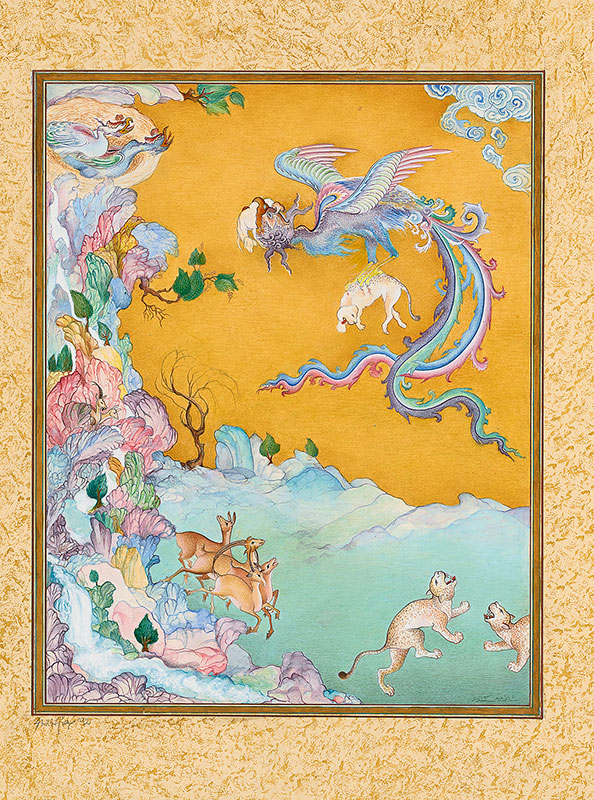
This scene—an example of Sikander’s early interest in fantastic creatures—refers to the extraordinary sixteenth-century manuscript known as the Shahnama of Shah Tahmasp, now disassembled. Based on a leaf at the Smithsonian’s Arthur M. Sackler Gallery, Sikander’s version focuses on the simurgh, a magical bird from Persian mythology. The simurgh symbolizes divinity in the twelfth-century Sufi allegorical tale The Conference of the Birds. In Islamic belief, birds in flight are associated with the ascension of the soul to a higher realm. Birds are rich in personal meaning for Sikander, who frequently equates them with imagination.
Shahzia Sikander (born 1969)
Simurgh Study after “Zal Is Sighted by a Caravan,” Attributed to Abdul Aziz, 1988
Watercolor on wasli paper
Collection of William Drew and Ruth Davis
© Shahzia Sikander. Courtesy: the artist, Sean Kelly, New York and Pilar Corrias, London.
Shazia Sikandar: This work is very important for me for several reasons. It references a page from the acclaimed illustrated 16th-century manuscript Shah Tahmasp Shahnama, which later was called the Houghton Shahnama, after the collector, Arthur Houghton, who in 1960s started to disassemble the manuscript into separate folios, many of which are now housed at Met. It's a very fascinating story of provenance. It is important in my practice to follow the provenance of objects, to understand the history of much of Islamic art in how it came to be in Western museum's collections. So the Shahnama is over 50,000 rhyming couplets. It was authored by the 10th century Persian poet Firdausi. The poem narrates the history of the ancient kings of Iran and is both mythical and historical. There is in there the allegorical tale of the simurgh, who also appears in another Persian poet's work, Farid-al-Din-Attar, who wrote the epic poem Conference of the Birds, which is a Sufi or mystical work where a flock of birds journey in pursuit of the mythical simurgh, a metaphor for the search of truth and enlightenment. So in many cases, simurgh is a female. It is always sort of hovering in the space between earth and sky. It's often seen simultaneously, near and far; visible, invisible; colorless or full of colors. And that's exactly the topic that I wanted to explore as a young artist.
